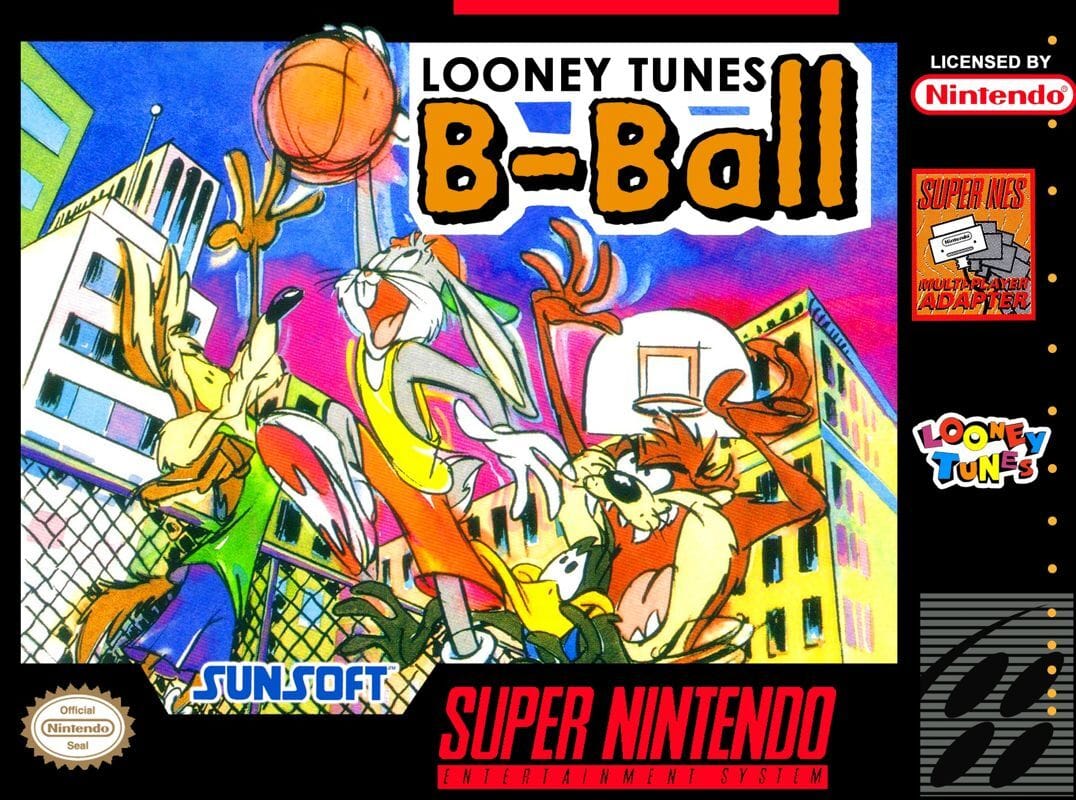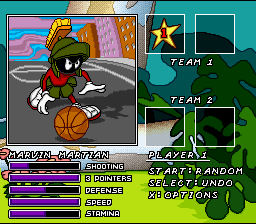- Retro XP
- Posts
- It's new to me: Looney Tunes B-Ball
It's new to me: Looney Tunes B-Ball
NBA Jam not cartoony enough for you? Sunsoft had a solution.
This column is “It’s new to me,” in which I’ll play a game I’ve never played before — of which there are still many despite my habits — and then write up my thoughts on the title, hopefully while doing existing fans justice. Previous entries in this series can be found through this link.
Arcade basketball was not a new concept when NBA Jam arrived in 1993, but Midway’s classic two-on-two game was a turning point, anyway. It featured licensed players and teams, ridiculous physics that allowed players to jump extremely high and dunk the ball in absurd ways, and was popular enough to not only receive home ports, but for the publisher of those versions, Acclaim, to begin to developer their own home-exclusive variants and sequels. Midway, meanwhile, used the same approach to launch games in other sports that were based on Jam’s formula.
It’s no wonder, then, that copycats and iterations on the concept would appear on the scene in short order. How do you get more cartoonish than NBA Jam? Easy! Use actual cartoons, and somehow make things even more ridiculous on the realism side. It’s not enough to be able to dunk a basketball in a way no human being would ever be able to. You need to also turn the basketball into an orange cream dessert that can be thrown in an opponent’s face to pie them before you take advantage of their condition to drive the lane and score two. You need to be able to distract your opponents by pressing a button to run the most effective defense Bugs Bunny can deploy in any situation: dressing up like a woman. You need to bring in the Looney Tunes.
Developer Sculptured Software focused heavily on two things in their nearly two decades of existence, both before and after they became an Acclaim property: licensed games, and sports titles. Those two areas weren’t all they ever did, by any means, but those were the spaces they worked in the most often, and sometimes they even did both at the same time. Looney Tunes B-Ball is one example of this: sports games are regularly licensed, sure, but to feature real athletes, not Bugs Bunny. Sculptured Software managed that exact feat more than once, as they were also tasked with the video game adaptation of the movie Space Jam, owing to their familiarity with Toon-based hoops from the year prior.

Image credit: Moby Games
Even if you don’t know of Looney Tunes B-Ball, you’re likely aware of some of Sculptured Software’s other work. They were the co-developers alongside LucasArts of the Super Star Wars trilogy on the SNES, ended up working on turn-of-the-century NBA Jam home releases for Acclaim, and were responsible for home ports of arcade hits like the first three Mortal Kombat games, for consoles like the SNES (Mortal Kombat, Mortal Kombat II, Mortal Kombat III) and the Genesis (Mortal Kombat III).
Here, it wasn’t Acclaim contracting Sculptured Software, but Sunsoft, the holder of the Looney Tunes license at the time. Looney Tunes B-Ball plays an awful lot like NBA Jam on the surface, in the sense that it’s fast-paced, two-on-two basketball where a missed swipe at the ball on defense is an invitation for your opponent to drop two or three points on you in a hurry, but there are differences. A loose ball turns into a dog, which then runs around without the same kind of logic as a bouncing basketball applied. Gems are picked up on the court, giving you currency with which you purchase a variety of special offensive and defensive maneuvers. There’s the aforementioned “put Bugs Bunny in makeup and a dress and watch everyone, your teammate included, stop what they’re doing to go all Tex Avery” tactic, but you can also turn the basketball into a bomb with a lit fuse, or you could use the Back Door move on offense to teleport your teammate near the basket, opening up a chance for you to pass and score. There’s Vegas, where the scoreboard briefly turns into a slot machine that will add a multiplier to whatever you score on that play — you might end up with a negative here, however, as that’s how gambling works. There are others, too, and each player has a unique defensive play a la Bugs’ lady routine, but you can also play more standard defense and steal the ball, block it, or just straight up push a player as hard as you can with the Y button. Ain’t you a stinker?
You have quite a few characters to choose from here, and they’re all dressed for some two-on-two street ball. (They’re also all voiced by Mel Blanc-successor Greg Burson; there are limited clips, sure, but they’re of good quality as far as the SNES goes, and they sound accurate to the characters all the same.) Leading men Bugs Bunny and Daffy Duck are obviously here, as are Yosemite Sam and Sylvester. Elmer Fudd and Marvin the Martian can ball, as can Wile E. Coyote. The Tasmanian Devil is an option as well, but he’s the worst character going here, as far as skills go. There are some characters missing who you’d expect to see — can you believe the Porky Pig disrespect here? — but it’s also for the best that things didn’t get too wide-ranging, or else you’d have to try to play defense against the diminutive Tweety Bird. No one needs to get schooled by that pint-sized punk.
You’d think Bugs Bunny would be the star, but his defense is horrid and he has just average stamina and three-point capabilities, so he’s kind of a mid-tier player. He’s an excellent shot from inside the arc, however, and his special defense has been mentioned a couple of times in this piece for more reasons than just that it’s funny to use. You can always partner him with the game’s best players — Daffy or Yosemite Sam — in order to form an unstoppable duo. Let Bugs drive the rock down the lane while the absurd defensive skills of either Daffy or Yosemite Sam keep opponents from racking up points on the other end of the court.
Elmer Fudd is a hell of a scorer from any range, but he’s also slow and doesn’t play a strong defense. Wile E. Coyote’s best trait is his stamina — that checks out — but he’s weak on offense, which, yeah. You have watched him chase the Road Runner before, right? Successfully executing an offensive plan isn’t exactly in his wheelhouse. The Tasmanian Devil is only useful as a defensive presence, but you don’t want him anywhere near the ball otherwise. Yosemite Sam’s only negative is his atrocious speed, but he’s a force to be reckoned with on the court with or without the ball. Sylvester can shoot pretty well from close, and he’s got high-end stamina, but you’ll be shocked to find out he’s not much for defensive strategies. Marvin the Martian can’t handle the rock from inside the arc, but he’s a menace from long range and is as fast as anyone in the game.
Each of the game’s characters has their own basketball-flavored portrait art on the selection screen, which also shows you their rating in each of the five skill categories. You form two teams of two, and if you’re playing single-player, you only control the first of those if you decide to have the game set to “Follow” one player, instead of whichever happens to have the ball. So be mindful of who you’re picking with that second spot in that case, since you need them to complement your own game without your direct input.

Image credit: Moby Games
You can play a single game against the computer, or a tournament, and each of these modes has one- and two-player modes. You can also bring on the SNES four-player Multitap adapter, however, and play some actual two-on-two. There’s an exceptionally large difficulty range to choose from that goes from 1 at the easiest end to 10 at the most difficult, too, so even against just the computer you can get a ton of mileage out of this game, and you can set quarter length from just one minute all the way up to 10, with the default being two. That’s all well and good, but the most fascinating option in Looney Tunes B-Ball is the Wacky Meter. This determines how — wait for it — wacky a given game is going to be. The higher the meter, the weirder the games can get, which also means how many and which powers are available for you to use.
The Wacky Meter goes from one to five, and if you want the full Looney Tunes B-Ball experience, you have to crank that thing all the way to the right. You can ease into it, though, that’s fine, no one will judge you for working your way up to fully wackiness.
There’s not a ton here, with just the single-player vs. computer exhibition, the tournament, and the various multiplayer options, but only in the sense that there’s no season or franchise mode or anything. Not that there necessarily would be, considering this is arcade basketball meant for shorter runs and pick-up-and-play experiences. It’s plenty if that’s what you’re looking for, and thanks to the ability to dial down the wacky, it can even play a bit traditional if you prefer it to, instead of as an extremely Looney Tunes-flavored basketball game.
You should play it with the Wacky Meter all the way up, however, at least eventually. Having Elmer Fudd in his What’s Opera, Doc? getup, calling down lightning on the person holding the ball, is an experience that you shouldn’t miss out on just because it would normally be against the rules.
This newsletter is free for anyone to read, but if you’d like to support my ability to continue writing, you can become a Patreon supporter, or donate to my Ko-fi to fund future game coverage at Retro XP.